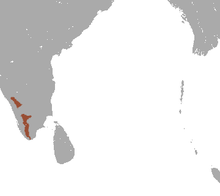| Nilgiri langur | |
|---|---|

| |
| Nilgiri langur eating fruit. | |

| |
| At Parambikulam. | |
| Conservation status | |
 Vulnerable (IUCN 3.1) | |
| Scientific classification | |
| Domain: | Eukaryota |
| Kingdom: | Animalia |
| Phylum: | Chordata |
| Class: | Mammalia |
| Order: | Primates |
| Suborder: | Haplorhini |
| Infraorder: | Simiiformes |
| Family: | Cercopithecidae |
| Genus: | Semnopithecus |
| Species: | S. johnii |
| Binomial name | |
| Semnopithecus johnii (J. Fischer, 1829) | |

| |
| Nilgiri langur range | |
| Synonyms | |
| |
The Nilgiri langur (Semnopithecus johnii) is an Asian langur of the Old World monkey. It has glossy, black fur and an orangey-golden brown, hair-like mane on its head. Females have a white patch of fur on the inner thigh. It typically lives in troops of nine to ten individuals, with or without offspring, depending on seasonality. Its diet consists of fruits, shoots and leaves. It is listed as vulnerable on the IUCN Red List and is threatened by habitat destruction and poaching for its body parts, thought to supposedly contain aphrodisiac properties.
Taxonomy and classification
The classification of the Nilgiri langur has been disputed. Traditionally it has been placed within the genus Trachypithecus based on morphological similarities such as cranial morphology and neonatal pelage color, and within the Trachypithecus vetulus group within Trachypithecus based on a presumed close relationship with the purple-faced langur (Semnopithecus vetulus), which had formerly been classified as T. vetulus. DNA and other evidence suggests that the Nilgiri and purple-faced langurs are more closely related to the gray langurs, and have thus been reclassified within the genus Semnopithecus.
Description
Adult males have a head-to-body length of 78–80 cm (31–31 in) and adult females of 58–60 cm (23–24 in); their tails are 68.5–96.5 cm (27.0–38.0 in) long. Males weigh 9.1–14.8 kg (20–33 lb) and females 10.9–12 kg (24–26 lb).
Distribution
The Nilgiri langur is native to the Nilgiri Hills of South India, where it occurs at elevations of 300–2,000 m (980–6,560 ft) in the states of Karnataka, Kerala and Tamil Nadu. It has been sighted in Agasthyamala Biosphere Reserve, Aliyar Forest Reserve, Anamalai Tiger Reserve, Bandipur National Park, Eravikulam National Park, Idamalayar Reserve Forest, Mudumalai National Park, Mukurthi National Park, Mundanthurai Tiger Reserve, Nelliampathi, Periyar National Park, Shendurney Wildlife Sanctuary and Silent Valley National Park.
Behaviour and ecology
The gestation period is not precisely known but assumed to be 200 days.
References
- ^ Singh, M.; Kumara, H.N.; Kumar, A. (2020). "Semnopithecus johnii". IUCN Red List of Threatened Species. 2020: e.T44694A17958623. doi:10.2305/IUCN.UK.2020-2.RLTS.T44694A17958623.en. Retrieved 19 November 2021.
- Groves, C. P. (2005). Wilson, D. E.; Reeder, D. M. (eds.). Mammal Species of the World: A Taxonomic and Geographic Reference (3rd ed.). Baltimore: Johns Hopkins University Press. p. 178. ISBN 0-801-88221-4. OCLC 62265494.
- Brandon–Jones, D.; et al. (2004). "Asian Primate Classification". International Journal of Primatology. 25 (1): 97–164. CiteSeerX 10.1.1.694.7983. doi:10.1023/B:IJOP.0000014647.18720.32. S2CID 29045930.
- Osterholz, M.; Walter, L.; Roos, C. (2008). "Phylogenetic position of the langur genera Semnopithecus and Trachypithecus among Asian colobines, and genus affiliations of their species groups". BMC Evolutionary Biology. 8 (58): 58. Bibcode:2008BMCEE...8...58O. doi:10.1186/1471-2148-8-58. PMC 2268674. PMID 18298809.
- Karanth, K.P.; Singh, L.; Collura, R.V.; Stewart, C.B. (2008). "Molecular phylogeny and biogeography of langurs and leaf monkeys of South Asia (Primates: Colobinae)" (PDF). Molecular Phylogenetics and Evolution. 46 (2): 683–694. doi:10.1016/j.ympev.2007.11.026. PMID 18191589.
- Wilson, D.E.; Mittermeier, R.A.; Rylands, A.B. (2012). "Introduction". Handbook of the Mammals of the World, Volume 3: Primates (1st ed.). Lynx Edicions. ISBN 978-8496553897.
- Wang, X.P.; et al. (2012). "Phylogenetic Relationships among the Colobine Monkeys Revisited: New Insights from Analyses of Complete mt Genomes and 44 Nuclear Non-Coding Markers". PLoS One. 7 (4): e36274. Bibcode:2012PLoSO...736274W. doi:10.1371/journal.pone.0036274. PMC 3338693. PMID 22558416.
- ^ Malviya, M.; Srivastav, A.; Nigam, P.; Tyagi, P. C. (2011). Indian National Studbook of Nilgiri Langur (Trachypithecus johnii) (PDF). Wildlife Institute of India, Dehradun and Central Zoo Authority, New Delhi.
- Govt of India (2020). The Gazette of India (PDF). Government of India. p. 20. Retrieved 14 April 2022.
External links
| Taxon identifiers | |
|---|---|
| Trachypithecus johnii |
|
| Simia johnii | |